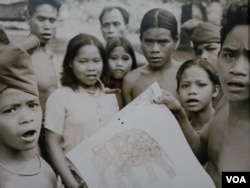PHNOM PENH - A child with a half-shaved head stares straight at us with a challenge in his eyes. Another group of children, one smoking a pipe, crowd around and stare, open-mouth and plaintive, as if they are about to break into shouts. A woman points a gun straight ahead, seemingly just a hair to the left of our heads.
These are all scenes from a new photography exhibition, "Cambodia in the 1960s," at Phnom Penh's Bophana Audiovisual Resource Center, which pays tribute to the late American historian and anthropologist Michael Vickery.
The exhibit showcases photographs from Vickery's archive that provide rarely seen glimpses into rural Cambodian lives from the 1960s.
One of the most striking features of the works on display is their subjects' interaction with the photographer, a sign of how deeply engaged Vickery was with the people and situations he encountered. Many of them stare out of the frame and directly at the viewer, making them startling in their immediacy, even 50 years later.
The photographs also show the affection and dedication the American had for Cambodia, where he made his home until his death last year at the age of 86. Vickery worked as an English teacher in Kompong Thom, Siem Reap and Phnom Penh in the 1960s and traveled extensively through rural Cambodia before earning a PhD from Yale University in 1977. He then established himself as an expert on Cambodia and the region, with particular expertise in Angkorian and post-Angkorian history.
Most depictions of pre-Khmer Rouge Cambodia focus on the lifestyle of city-dwellers: people who listened to rock music, lived among modernist buildings, and worked in offices or busy markets.
But Vickery was always more interested in the lives of remote communities and ethnic minority tribes, and his photographs reflect this. The people he photographed would have lived much as their ancestors did, farming rice or foraging in forests.
Young Sokphea, a panelist during a presentation at the French Cultural Center that coincided with the opening of the exhibition, said Vickery's photographs were especially interesting for this reason.
“The photos the people usually took at the time were in the city," said Sokphea, a post-doctoral researcher at University College, London, who studies the role of images and photographs in the political imagination.
"So what I received for my research are mostly photos of people in the city. However, there were not many photos taken in the rural areas.”
Sokphea said that many ethnic minorities in remote areas in the 1960s were barely seen as citizens, and were therefore not photographed often or incorporated into state systems of control and identification.
"If visual means like ID photos are a means of recognizing a person as a citizen of a state, what if a person could not be photographed or did not have a photo ID?” he asked.
In his book “Cambodia 1975-1982,” Vickery wrote of the stark differences he saw between Cambodia’s cities and fertile rice-growing regions and the far-flung villages he visited on his travels, which he described as self-sufficient, hostile to outsiders, and barely incorporated into the state.
“This other Cambodia was virtually untouched by any kind of ethnographical or sociological study, but from the few glimpses we have we can safely say that no assumptions about Cambodian life, attitudes, mores and beliefs based on observations of the central rice-growing and gardening zones are likely to be accurate for the outer regions,” he wrote.
Despite Vickery's copious efforts to document what he saw in the countryside, he never released or published his photographs. His adopted daughter, Amema Saeju, who was born into the Lisu tribe in Northern Thailand, found and collected them after his death.
She said he took photographs compulsively, out of a habit of documenting the world, but had no intention of ever displaying them.
"In my experience with him as a foster daughter, I asked him many times too and when I tried to arrange the photographs, I complained sometimes: 'Dada, why are you taking so many photographs? It's so big, so much.'
"And he said, 'Well, I took it because I like it. I like traveling and seeing people."
The exhibition runs until November 5.
